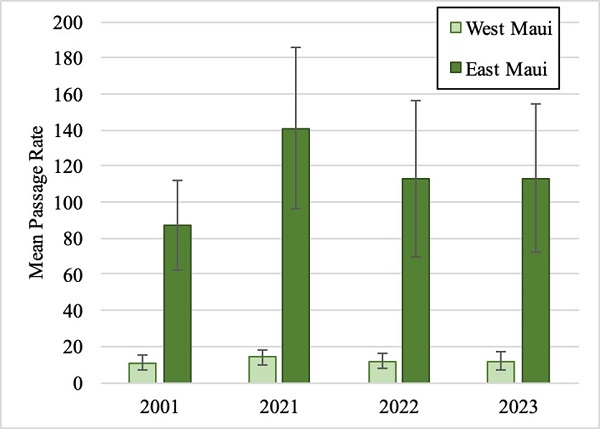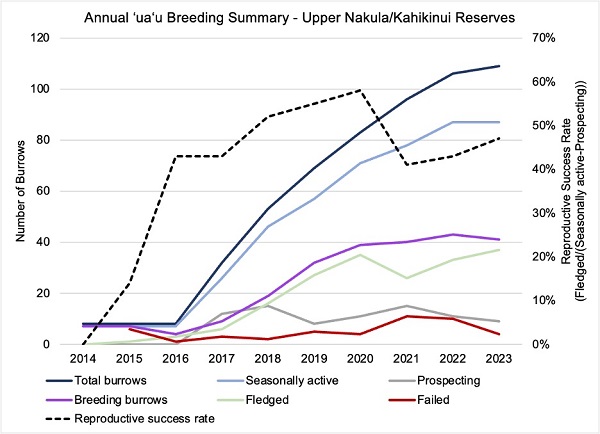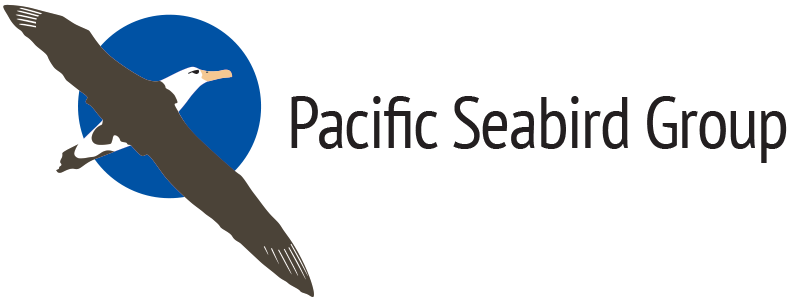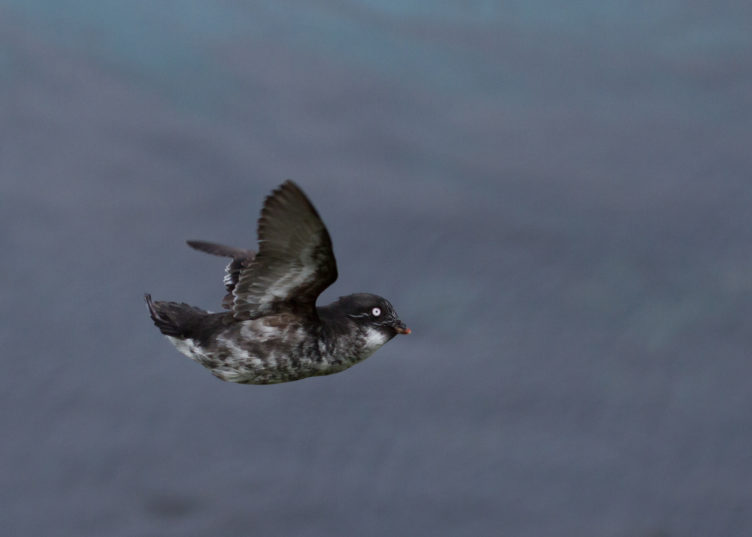Learned & Penniman (2024)
Author Information
Jenni Learned and Jay Penniman: Maui Nui Seabird Recovery Project
Maui Nui Seabird Recovery Project Regional Report – Maui, Hawaiʻi
Ornithological radar surveys on Maui, Hawaiʻi
In 2020 the Hawaiʻi Division of Forestry and Wildlife (DOFAW) provided a marine radar to the Maui Nui Seabird Recovery Project (MNSRP). The marine radar was selected to closely match that used for seabird surveys on Maui in 2001 by ABR. With funding and support from American Bird Conservancy, Hawaiʻi DOFAW, and Haleakalā National Park, MNSRP replicated the 2001 ABR surveys in 2021, 2022, and 2023. Surveys will continue annually in June as funding allows. Current surveys replicate the original 15 sites located around Maui Island, with minor modifications for access and with the addition of four new locations. Survey targets are three endangered seabird species: ʻUaʻu (Pterodroma sandwichensis; Hawaiian Petrel; HAPE), ʻAʻo (Puffinus newelli; Newell’s Shearwater; NESH), and ʻAkēʻakē (Hydrobates castro; Band-rumped Storm-petrel; BANP). Observers accompanying the radar surveys visually and aurally identified only ʻUaʻu during the three years of this study with no confirmed identification of ʻAʻo or ʻAkēʻakē. Without confirmation of the other species, it is assumed that most radar targets are ʻUaʻu. This is supported by radar survey results showing significantly higher passage rates for East Maui sites, which are in the path of ʻUaʻu transiting to the largest extant colony, located in high elevation habitat on Haleakalā. Overall, current passage rates are similar to or greater than rates in 2001, suggesting that the management of ʻUaʻu in East Maui is having a positive impact on the species. See Figure 1 for average radar rate comparisons.

Social attraction for endangered seabirds at Makamakaʻole, Maui, Hawaiʻi
The Makamakaʻole seabird protection site consists of two exclosures constructed with mammal exclusion fencing and set up for social attraction of ʻAʻo and ʻAkēʻakē in exclosure A, and ʻUaʻu in exclosure B. Social attraction methods include artificial nest boxes and visual decoys for ʻAʻo and ʻUaʻu, nest boxes and ceramic burrows (sourced from Oikonos Ecosystem Knowledge) for ʻAkēʻakē, and broadcast playback for all three species. ʻAʻo return to both exclosures to breed annually, and in 2023 produced 20 eggs among 33 active burrows. One burrow has produced a single ʻAʻo chick for each of the past three breeding seasons. Genetic sampling done on 18 individuals to date shows that all sampled adults are female. Besides a carcass discovered in a nest box in 2020, no ʻAkēʻakē have yet been detected at Makamakaʻole. No ʻUaʻu have been documented visiting artificial burrows.
Endangered ʻuaʻu management in Nakula Natural Area Reserve and Kahikinui Forest Reserve
The MNSRP manages and protects breeding ʻUaʻu in the portion of the Haleakalā population that extends down the leeward slope into upper Nakula and Kahikinui. Following the construction of an ungulate-proof fence in 2014 (DOFAW), MNSRP began regular predator control (trapping rodents, mongooses, and cats), burrow monitoring (monthly burrow checks and motion-activated game cameras), vegetation surveys, and annual burrow searching. The number of identified burrows has increased from 8 in 2014 to 109 in 2023. Average reproductive success is around 50%. See Figure 2 for a summary of annual trends. The increase of ʻUaʻu activity within Nakula and Kahikinui is supported by acoustic data, collected with passive acoustic monitors deployed throughout the sites every three years (2014, 2017, 2020, 2023). ʻUaʻu call rates increase over time, most significantly at sampling locations adjacent to the crater rim and the denser parts of the colony within the National Park. The management activities of Haleakalā National Park, Hawaiʻi DOFAW, and MNSRP together have benefited ʻUaʻu and allowed their population to expand.

ʻUaʻu kani population monitoring in Maui Nui, Hawaiʻi
ʻUaʻu kani (Ardenna pacifica; Wedge-tailed Shearwater; WTSH) are indigenous Hawaiian seabirds that breed coastally throughout the archipelago and on offshore islets. In Maui Nui (Maui, Molokai, Lānaʻi, Kahoʻolawe), MNSRP and partners Pūlama Lānaʻi, The Nature Conservancy, and Molokai Land Trust monitor the demographics and reproductive success of ʻUaʻu kani at six primary colonies. Burrow counts, occupancy rates, and burrow density determinations are used to estimate total pairs for all areas with ʻUaʻu kani activity across Maui Nui, including offshore islets. MNSRP estimates over 13,000 breeding pairs in 2023. Colony management (predator removal, habitat restoration) in recent years has led to an increase in ʻUaʻu kani. For example, in 2017 the burrow count at Kamaʻole III in Kihei, Maui, was around 400. Following a trapping program and invasive vegetation management implemented in 2018, burrow numbers climbed to almost 1500 in 2023. MNSRP also manages a long-term banding program for ʻUaʻu kani (1999–present). Chick banding and adult capture-recapture occur annually at the main colonies. Banding data also show that recovered fallout birds (grounded by light distraction) later return to the colonies as successful breeders.
Monitoring of Sulidae at Pauwalu Point, East Maui
Pauwalu Point is a state designated seabird sanctuary (DOFAW) located on an undeveloped and elevated peninsula on Maui’s windward coast. Since the establishment of a breeding population of red-footed ʻĀ (Sula sula; Red-footed Booby; RFBO) around 2018, the MNSRP with DOFAW partners have been performing regular surveys to monitor and track seabird activity at Pauwalu and associated offshore islets. Drone surveys indicate growth and expansion of the red-footed ʻĀ colony throughout the peninsula. Breeding brown ʻĀ (Sula leucogaster plotus; Brown Booby; BRBO) are also monitored on the adjacent islet Moku Mana. Since 2019, Brewster’s ʻĀ are also observed breeding on Moku Mana (Sula leucogaster brewsteri; Brewster’s Booby, BRBO). Regular surveys of ʻĀ at Pauwalu contribute to the understanding of range expansions for these species.






